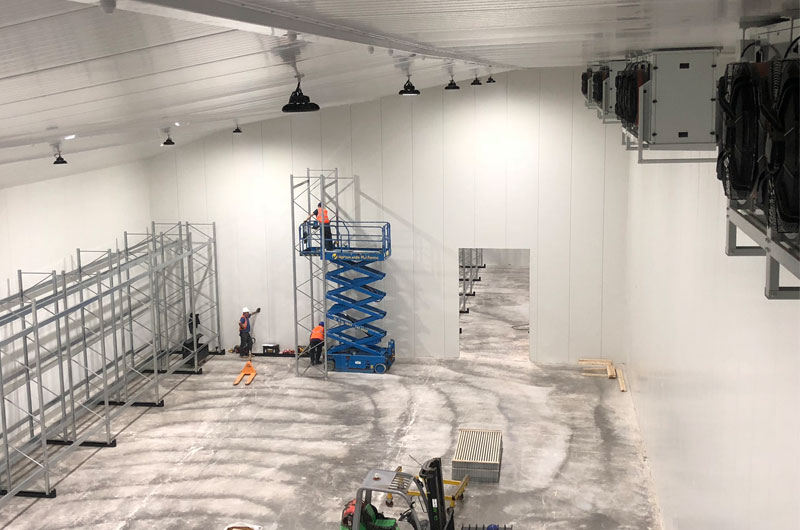As technology advances and operational needs change, many existing cold rooms become outdated, inefficient, and expensive to operate.
Instead of replacing the entire system, upgrading your current cold room can provide significant energy savings, improve temperature control, and extend the lifespan of your equipment.
1. Evaluate Current Performance and Identify Weak Points
Before making any upgrades, conduct a detailed assessment of the current performance. This should include:
- Energy consumption analysis: Monitor electricity usage over time to spot inefficiencies.
- Temperature consistency check: Identify any hot spots or fluctuating zones inside the room.
- Insulation integrity: Check for signs of deterioration, moisture, or thermal bridging.
- Equipment condition: Inspect compressors, evaporators, condensers, fans, and sensors for wear and inefficiency.
Engage a professional cold storage technician or energy auditor to perform a thermal imaging scan or air leakage test to pinpoint areas of concern.
2. Upgrade Insulation and Paneling
Insulation is a cornerstone of cold room efficiency. Even minor degradation can lead to heat ingress and increased compressor workload. Consider:
- Replacing damaged panels: Upgrade to high-performance polyurethane or PIR (polyisocyanurate) insulated panels.
- Increasing insulation thickness: For older rooms with thinner walls, thicker insulation (≥ 100mm) significantly reduces thermal loss.
- Sealing air leaks: Use high-quality weather stripping and sealants to plug gaps around doors, vents, and corners.
Better insulation reduces compressor runtime and improves temperature stability, especially in hot climates or high-humidity environments.
3. Upgrade Doors and Access Control
Cold room doors are a major point of energy loss. If your doors are outdated, warped, or frequently left open, it’s time to upgrade:
- Install automatic or self-closing doors: These minimize door-open time and reduce heat exchange.
- Add strip curtains or air curtains: These create a thermal barrier when doors are open.
- Improve door seals: Magnetic gaskets and heavy-duty sweeps help maintain an airtight closure.
- Introduce access control systems: Use motion sensors, RFID access, or alarms to prevent unauthorized or unnecessary door openings.
Controlling access reduces infiltration of warm air and moisture, both of which increase energy usage.
4. Modernize Refrigeration Systems
Refrigeration is the heart of your cold room and the biggest energy consumer. Switching to a more energy-efficient system can significantly reduce electricity expenses. Consider:
- High-efficiency compressors: Inverter-driven compressors adjust output based on cooling load, reducing energy waste.
- EC (electronically commutated) fans: These use less energy and provide more precise airflow control than traditional AC fans.
- Variable speed drives (VSDs): Allow fans and pumps to match performance to load demand.
- Smart defrost controls: Eliminate unnecessary defrost cycles, conserving energy and preserving product quality.
Additionally, retrofitting with eco-friendly refrigerants can help you meet environmental regulations and improve thermodynamic efficiency.
5. Improve Airflow and Evaporator Performance
Poor airflow causes uneven cooling and makes equipment work harder. Ensure:
- Proper evaporator placement: Evaporators should not be blocked by shelving or stock.
- Regular coil cleaning: Dust and ice buildup reduce heat exchange efficiency.
- Deflector installation: Air deflectors guide airflow and prevent short cycling of cold air.
- Fan upgrades: As mentioned earlier, switching to EC fans increases energy savings and reliability.
Consistent maintenance and optimized airflow help eliminate hot spots and maintain even temperature levels throughout the space.
6. Integrate Smart Monitoring and Controls
Modern cold room control systems allow real-time monitoring and automatic adjustments. These smart systems offer:
- Temperature and humidity sensors: Ensure optimal storage conditions and alert you to anomalies.
- Remote access and alarms: Monitor conditions and receive alerts via mobile or desktop apps.
- Data logging: Track performance trends for maintenance planning and regulatory compliance.
- Predictive maintenance: AI-driven systems can anticipate equipment failure and suggest preventative action.
Digital control reduces manual errors and enables proactive decision-making.
7. Optimize Lighting for Efficiency and Heat Reduction
Lighting is often overlooked but can significantly affect internal temperatures. Replace outdated lighting with:
- LED fixtures: LEDs produce minimal heat, use less electricity, and last longer than traditional bulbs.
- Motion sensors or timers: Prevent lights from staying on unnecessarily.
- Cool-white lighting: Provides better visibility and enhances energy efficiency.
Lowering internal heat generated by lighting reduces strain on the cooling system.
8. Implement Routine Maintenance and Staff Training
Even the most advanced upgrades will underperform without proper upkeep. Establish a regular maintenance schedule that includes:
- Coil and fan cleaning
- Refrigerant level checks
- Seal and door inspections
- Temperature calibration
At the same time, train staff on:
- Efficient loading/unloading practices
- Minimizing door-open time
- Reporting anomalies quickly
A well-informed team and a well-maintained system ensure long-term efficiency.
9. Consider Renewable Energy Integration
If you’re looking to reduce operating costs and your environmental impact, consider renewable options:
- Solar panels: Offset the cold room’s electricity consumption.
- Battery storage: Capture and store surplus energy for use during high-demand periods.
- Solar-assisted refrigeration: Pre-cool air or use thermal energy storage systems.
Although the upfront cost may be higher, the long-term return on investment can be substantial, particularly when government incentives are available.
10. Reassess Layout and Usage Patterns
Finally, assess how you use your cold room:
- Reorganize shelving: Avoid blocking airflow or stacking goods too close to evaporators.
- Improve space utilization: Use vertical racking systems to maximize storage efficiency.
- Evaluate load patterns: Optimize delivery and loading schedules to reduce warm air infiltration.
Operational efficiency complements mechanical upgrades to deliver the best results.

